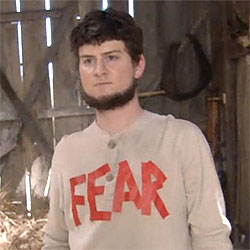 |
Lovely snowy day. I actually adjusted the contrast
so the peak would stand out. The sky was
bright and sunny directly overhead. |
What an amazing week I've had! I've rubbed elbows with huge names in my industry, learned tips and tricks to writing, watched some amazing films and TV series, and basicaly filled my writing notebook with amazing information.
I feel so blessed to have participated in BYU's writer's conferences nestled deep in the mountains near the Sundance Ski Resort. For four days, the conference convened at a lodge BYU has on the back side of Mt. Timpanogos that I never knew existed. It snowed, it rained, and we even had perfect weather. But more importantly, we had amazing guest speakers that offered insight into the screenwriting process and the overall world of screenwriting.
 |
| View of Timp from the porch of the lodge. |
About 70 or so students, alumni, and guests heard from faculty and staff from the Theater and Media Arts Department (one department with two branches), including the chair, Wade Hollingshaus, who I have never met before the conference.
 |
| Jared & Jerusha Hess |
We also met Jared and Jerusha Hess, BYU Alumni and the creators of
Napoleon Dynamite,
Nacho Libre, and
Masterminds, which we watched during the conference. Jerusha held a workshop where we discussed ways to improve our scripts and characters. I asked her how to improve story arc when the plot is weak, but the characters are strong. From her and other information I got during the conference, I learned that often when you have strong characters and a weak plot, your story is better for a series than a feature. Basically you take your strong characters and place them in small vignettes and find connecting themes to link them together. It is almost like an experiment - take a group of people, dump them in a situation, and see how it plays out. Feature length film is very different. You must have that strong arc - someone wants something very bad and is having a difficult time getting it.
 |
| Rebecca Thomas |
Rebecca Thomas, who directed an episode of
Stranger Things, the feature
Electrick Children, and is a BYU Alumni, was interviewed and fielded questions from the group.
 |
| Jonathan Krisel |
We also had the pleasure of meeting and learning from
Jonathan Krisel. He wrote for SNL, created
Portlandia, and one of my new favorite shows,
Baskets, and has been nominated for nine primetime Emmys. One thing I really appreciated about his work, especially what I see in
Baskets, is that he is charitable with his characters. Some of them are real ding-dongs (a new phrase I picked up from the writers at the conference, and will use frequently now), but Krisel does a wonderful job at not humiliating or degrading odd people, but "celebrating their weirdness" as he put it. We often see the twinge of humanity in these people, and immediately feel empathy for them. This is something that I have decided to incorporate in my writing.
Have you ever watched an episode of
The Office where Dwight Schrute is on his beet farm? If you have, you most likely have seen Mose Schrute, Dwight's silent Amish cousin.
 |
| Mose Schrute, a.k.a Michael Schur |
Well this guy is actually
Michael Schur, one of the writers of this show who was there since the first season. He also went on to create the hit series,
Brooklyn Nine-Nine, and
Parks & Rec, starring Amy Poehler, Chris Pratt, Nick Offerman, Aubrey Plaza, and Rashida Jones. He has now created another fantastic series called
The Good Place. This quickly has become one of my favorite series exploring the concepts of morals and ethics in a funny after-life kind of way. So I'm sure you guessed it - he came and spoke with us as well. The man is brilliant - studied at Harvard - also did a stint at SNL, but only after being called back several months after losing his first interview to another writer by the name of Tina Fey. Yes, that Tina Fey.
Schur taught us some very important principles about screenwriting. One thing I thought was interesting is how as a writer, we might have an idea who the character is. But often the actor will bring something to the table that will require you to adjust your perspective. And as a writer, if you don't listen to the actors, you may need to step back and reconsider your approach to screenwriting. He used the example from
Parks & Rec of the character of Ron Swanson. Originally Ron was supposed to be a conniving, corrupt bribe-taking politician. Schur explained that Nick Offerman is actually full of integrity, so it was odd for him to play the character that way. Also Offerman really does build his own canoes as we see Ron Swanson doing in an episode. So Offerman changed who Ron Swanson is, and thankfully because Ron is such a fun character as Offerman plays him.
I have a notebook of other great advice from all of these amazing guests at the conference, but I think I'll keep them to myself. One last little thing I must say. Courtney and Tom Russell, thank you so much from the bottom of my heart for all of your hard work and dedication to making this writer's conference such an amazing experience. Also to Jared who cooked some of the best food I've had (dreaming about that Alfredo sauce now... YUM!).













